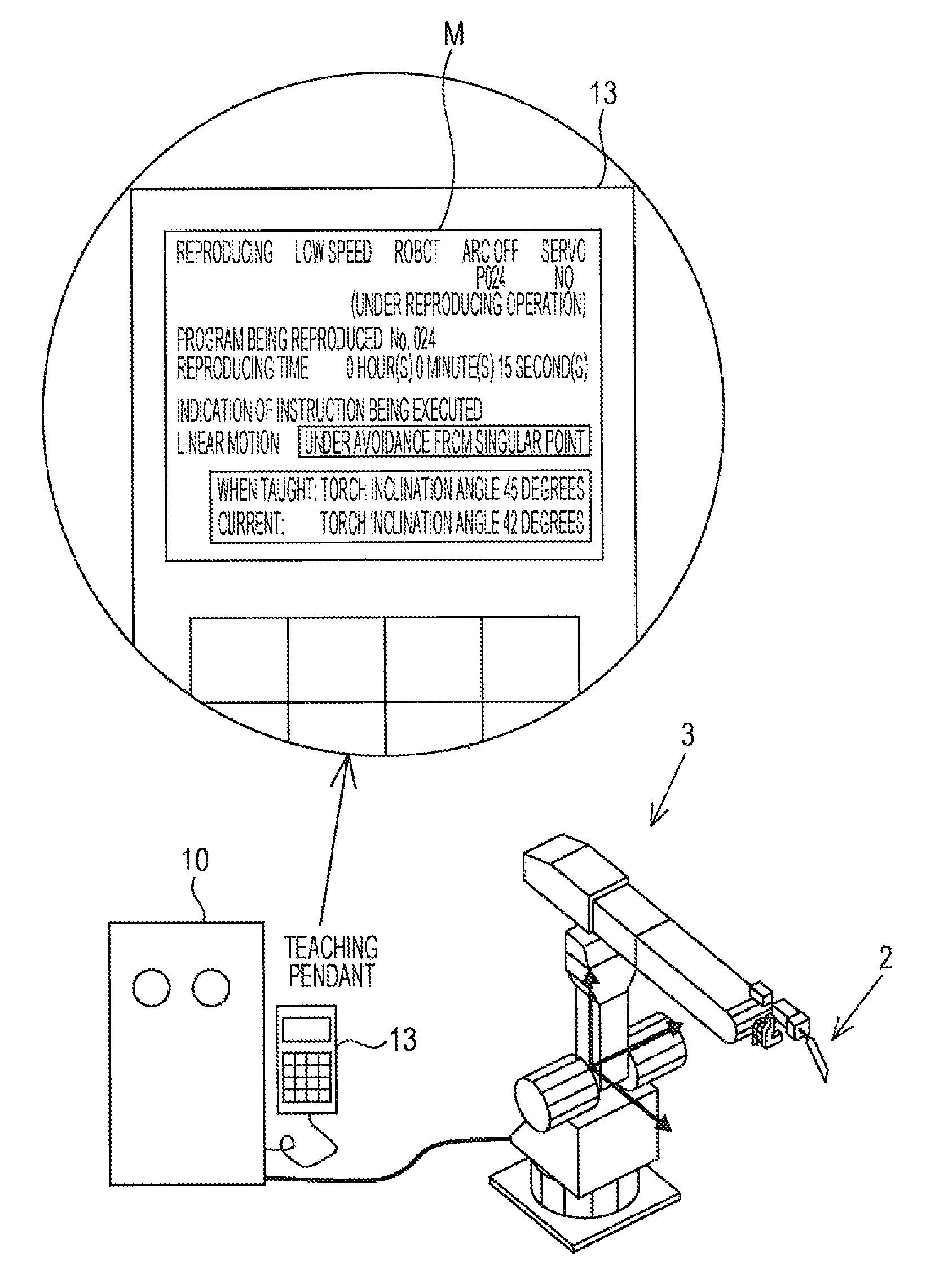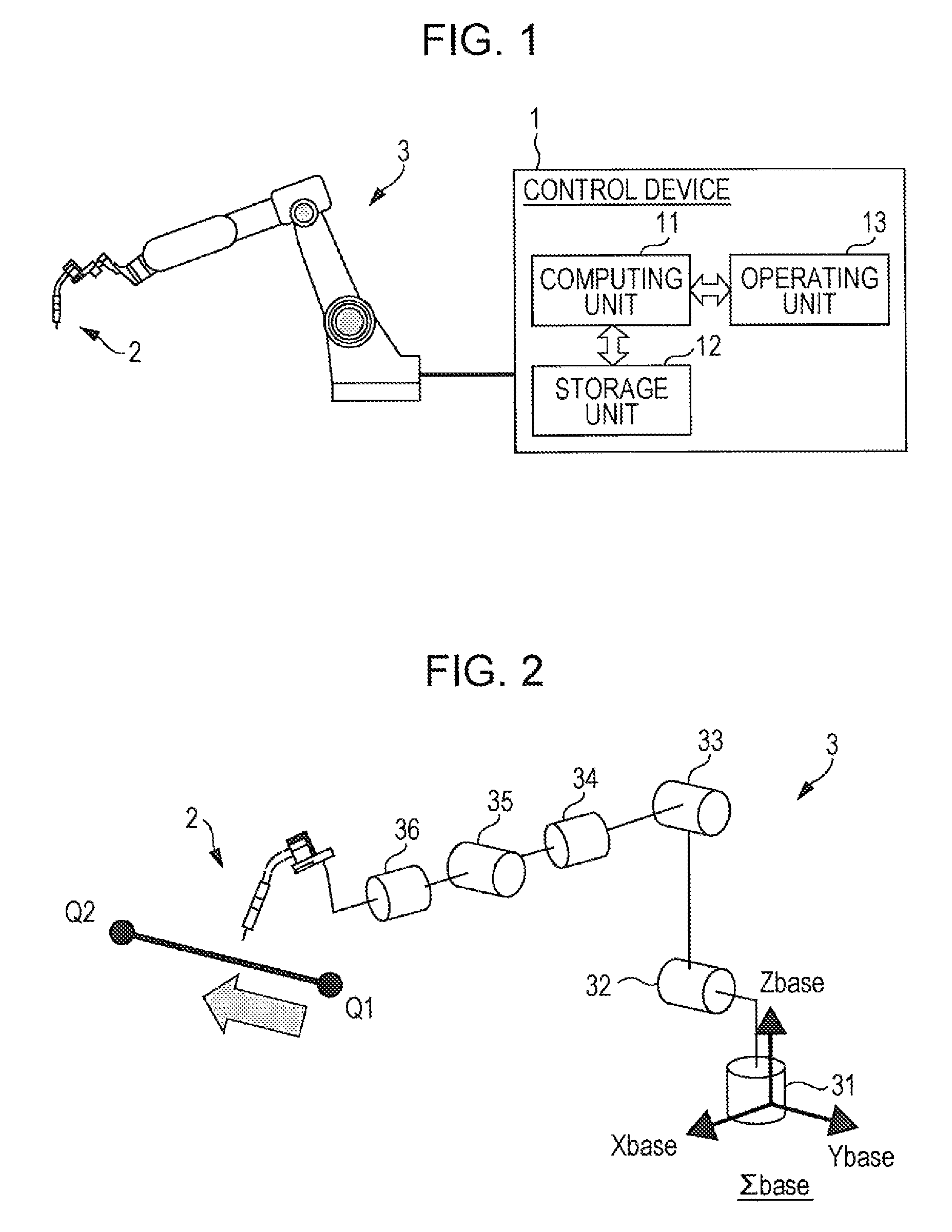Control device, control method, and control program for articulated robot
a robot and control device technology, applied in the direction of program control, electric programme control, instruments, etc., can solve the problem that the angle of the j5 axis cannot be made to reach the angle to be taken at the work end poin
- Summary
- Abstract
- Description
- Claims
- Application Information
AI Technical Summary
Benefits of technology
Problems solved by technology
Method used
Image
Examples
example 1
[0088]In EXAMPLE 1, another example of the exception example in the above-described robot control process (see FIG. 3) is described.
[0089]More specifically, in EXAMPLE 1, the control device 1 determines in above step S61 that the exception condition is satisfied, when the angle of at least one of the drive shafts 34 to 36 at the next interpolation point exceeds a preset operation range. Assuming, for example, that respective limits of preset plus-side operation ranges of the drive shafts 34 to 36 are θ4+L, θ5+L and θ6+L, and that respective limits of preset minus-side operation ranges of the drive shafts 34 to 36 are θ4−L, θ5−L and θ6−L, the control device 1 determines that the exception condition is satisfied, when at least one of the following formulae (41) to (46) is held. The operation ranges of the drive shafts 34 to 36 are, for example, allowable operation ranges of drive motors for the drive shafts 34 to 36.
θ4(t)>θ4+L (41)
θ4(t)L (42)
θ5(t)>θ5+L (43)
θ5(t)L (44)
θ6(t)>θ6+L (...
example 2
[0096]Another example of the above-described exception condition used in the robot control process (see FIG. 3) will be described in EXAMPLE 2.
[0097]FIG. 9 is a flowchart illustrating one example of procedures of a robot control process according to EXAMPLE 2. It is to be noted that similar processing procedures to those in the above-described robot control process (see FIG. 3) are denoted by similar symbols and description thereof is omitted.
[0098]More specifically, as illustrated in FIG. 9, steps S21, S31, S41 and S611 described below are executed in the robot control process according to EXAMPLE 2 instead of above steps S2, S3, S4 and S61, respectively.
(Steps S21, S31 and S41)
[0099]In step S21, the control device 1 calculates not only the angles θ4e, θ5e and θ6e of the drive shafts 34 to 36 at the work end point Q2, but also the angles θ4s, θ5s and θ6s of the drive shafts 34 to 36 at the work start point Q1.
[0100]In step S21, the control device 1 further calculates respective ang...
example 3
[0109]EXAMPLE 3 is intended to execute copying control in which the control device 1 controls the articulated robot 3 in such a manner that the end effector 2 is moved to trace a work line of a workpiece. In this case, a sensor (corresponding to deviation amount detecting means) for detecting a deviation amount ΔXYZαβγ(t) between the end effector 2 and the work line is disposed on the articulated robot 3.
[0110]Herein, the deviation amount ΔXYZαβγ(t) detected by the sensor at each detection time is a value represented on the basis of the interpolation point at the relevant detection time, which is calculated using the above-described path equation P(t). The control device 1 executes the copying control for moving the end effector 2 to trace the work line based on the detection result of the sensor. The control device 1 in executing the copying control corresponds to copying control means.
[0111]In more detail, when calculating the next interpolation point in step S5 of the above-descr...
PUM
| Property | Measurement | Unit |
|---|---|---|
| angles | aaaaa | aaaaa |
| angle | aaaaa | aaaaa |
| angle θ5e | aaaaa | aaaaa |
Abstract
Description
Claims
Application Information
 Login to View More
Login to View More - R&D
- Intellectual Property
- Life Sciences
- Materials
- Tech Scout
- Unparalleled Data Quality
- Higher Quality Content
- 60% Fewer Hallucinations
Browse by: Latest US Patents, China's latest patents, Technical Efficacy Thesaurus, Application Domain, Technology Topic, Popular Technical Reports.
© 2025 PatSnap. All rights reserved.Legal|Privacy policy|Modern Slavery Act Transparency Statement|Sitemap|About US| Contact US: help@patsnap.com



